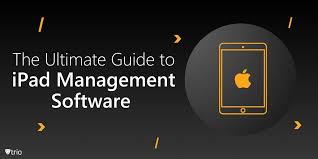In a world increasingly reliant on technology, the management of devices like the Apple iPad has become pivotal for both individuals and organizations. As iPads are widely integrated into educational institutions, businesses, and personal workflows, effective management software is essential. This article delves into the various aspects of Apple iPad management software, providing an in-depth understanding of its significance, features, benefits, and implementation strategies.
Table of Contents
- Understanding iPad Management Software
- Key Features of iPad Management Software
- Benefits of Using iPad Management Software
- Popular iPad Management Solutions
- How to Choose the Right iPad Management Software
- Implementation Strategies for iPad Management Software
- Case Studies: Success Stories of iPad Management Software
- Future Trends in iPad Management Software
- Conclusion
1. Understanding iPad Management Software
Apple iPad management software refers to a suite of tools designed to help organizations manage, deploy, and secure iPads efficiently. This software enables administrators to control multiple devices from a central location, providing essential capabilities such as app management, device tracking, and security policies.In educational settings, for instance, iPad management software allows teachers to oversee student devices, ensuring that educational resources are used appropriately. In businesses, IT departments can monitor device health and security, ensuring compliance with corporate policies. Understanding the scope and functionality of iPad management software is crucial for maximizing the benefits of iPad use.This software typically operates via a Mobile Device Management (MDM) framework, enabling features like remote wipe, configuration profiles, and automated updates. Solutions often integrate with Apple’s Device Enrollment Program (DEP) for seamless device onboarding, which significantly reduces setup time.
2. Key Features of iPad Management Software
When evaluating iPad management software, several key features should be considered:
- Device Enrollment and Configuration: Efficiently enroll and configure multiple iPads through automated processes.
- App Management: Deploy, update, and manage apps remotely, ensuring that devices have the latest tools available.
- Content Management: Distribute educational or corporate content securely, controlling what users can access.
- Security Features: Implement security protocols, such as remote lock, wipe, and password enforcement, to protect sensitive data.
- Monitoring and Reporting: Gain insights into device usage, compliance, and performance through comprehensive reporting tools.
- User Management: Create user profiles and manage permissions to tailor access based on roles or classroom needs.
These features not only streamline device management but also enhance user experience, ensuring devices are used effectively within their intended contexts.
3. Benefits of Using iPad Management Software
The adoption of iPad management software comes with numerous benefits, including:
- Increased Efficiency: Automated processes reduce the time and effort needed for device setup and maintenance.
- Enhanced Security: With robust security features, organizations can mitigate risks associated with lost or stolen devices.
- Cost Savings: By managing devices more effectively, organizations can reduce operational costs related to support and maintenance.
- Better User Experience: A centralized management approach ensures that users have access to the latest tools and resources, enhancing productivity.
- Scalability: As organizations grow, iPad management software can scale to accommodate additional devices without a hitch.
These benefits underscore the importance of integrating iPad management software into organizational workflows.
4. Popular iPad Management Solutions
Numerous iPad management solutions exist in the market, each offering unique features and capabilities. Some of the most popular options include:
- Jamf Pro: A comprehensive MDM solution specifically designed for Apple devices, offering powerful management features and seamless integration with Apple services.
- MobileIron: Known for its strong security features, MobileIron provides MDM capabilities for a range of devices, including iPads.
- Microsoft Intune: Part of the Microsoft 365 ecosystem, Intune offers robust device management and security features, making it ideal for organizations already using Microsoft products.
- Cisco Meraki: Combining MDM with network management, Cisco Meraki provides a holistic approach to device and network oversight.
Each of these solutions has its strengths, making it important for organizations to evaluate their specific needs when selecting a management tool.
5. How to Choose the Right iPad Management Software
Choosing the right iPad management software can feel overwhelming due to the variety of options available. To make an informed decision, consider the following factors:
- Compatibility: Ensure the software is compatible with the specific iPad models and iOS versions your organization uses.
- Features vs. Needs: Assess the features offered by the software and match them with your organization’s specific requirements.
- User Experience: A user-friendly interface can significantly reduce the learning curve for administrators and end-users.
- Support and Resources: Evaluate the level of customer support and training materials available from the vendor.
- Cost: Consider both the upfront costs and any ongoing fees associated with the software.
By carefully evaluating these factors, organizations can select the most suitable iPad management software for their needs.
6. Implementation Strategies for iPad Management Software
Implementing iPad management software requires careful planning and execution. Here are some effective strategies:
- Define Objectives: Clearly outline what you hope to achieve with the software, such as improved security or easier app deployment.
- Engage Stakeholders: Involve key stakeholders, including IT staff, educators, and end-users, in the implementation process to gather input and ensure buy-in.
- Pilot Testing: Conduct a pilot program with a small group of users to identify potential challenges and gather feedback before a full rollout.
- Training and Support: Provide comprehensive training for administrators and end-users to facilitate a smooth transition to the new system.
- Continuous Monitoring: After implementation, regularly assess the effectiveness of the software and make adjustments as needed.
These strategies can help organizations maximize the benefits of their iPad management software.
7. Case Studies: Success Stories of iPad Management Software
Real-world examples can illustrate the impact of iPad management software. Here are two case studies:
Case Study 1: Educational Institution
A school district implemented Jamf Pro to manage over 1,000 iPads used by students and teachers. By automating device enrollment and app distribution, the district reduced setup time by 75%. Teachers reported enhanced classroom engagement, as they could easily share resources and monitor student activity through the management software.
Case Study 2: Corporate Environment
A multinational corporation adopted Microsoft Intune to manage its fleet of iPads used by remote employees. With enhanced security features, the company successfully reduced data breaches by 60%. Employees appreciated the seamless access to corporate applications, which improved productivity and satisfaction.These case studies highlight the transformative potential of iPad management software in various settings.
8. Future Trends in iPad Management Software
As technology evolves, so do the features and capabilities of iPad management software. Some anticipated trends include:
- Artificial Intelligence Integration: AI may enhance device management by predicting maintenance needs and automating routine tasks.
- Enhanced Security Protocols: As cyber threats evolve, management software will likely incorporate advanced security measures to protect sensitive data.
- Cloud-Based Solutions: The trend towards cloud-based management will offer increased flexibility and scalability for organizations of all sizes.
- User-Centric Management: Future solutions may focus more on user experience, allowing for greater customization and personalization of device management.
Staying abreast of these trends can help organizations prepare for future developments in iPad management.
9. Conclusion
In conclusion, Apple iPad management software plays a critical role in the effective deployment, management, and security of iPads in various environments. By understanding the features, benefits, and implementation strategies of this software, organizations can make informed decisions that enhance productivity and security. As technology continues to advance, the importance of robust iPad management solutions will only grow, making it essential for organizations to prioritize this aspect of their digital strategy.
This comprehensive guide on Apple iPad management software aims to inform and educate readers on the importance and utility of these tools in today’s tech-driven world. By following the outlined strategies and keeping an eye on future trends, organizations can harness the full potential of iPads while ensuring security and efficiency.



